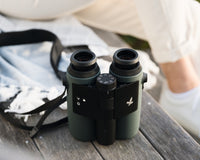
Magnification
The magnification specifies the factor by which an object appears to be closer in comparison with the actual distance. The higher the magnification, the closer the object seems to be. However, a higher magnification also means a smaller field of view. Check the precise product name as the number in front of the 'x' specifies the magnification. For example, 10x42 is a device with 10x magnification.
Field of View
The field of view describes the size of the image section that can be seen through the optics. This is specified either in metres (width) at a distance of 1000 metres (m/1000m), or feet (width) at a distance of 1000 yards (ft/1000 yds), or as an angle (degrees). The higher the magnification, the smaller the field of view.
Binoculars have a large field of view, which means you can see a wide area. Spotting scopes have a higher magnification, which makes the field of view much smaller, but you can see more detail.
Objective Lens Diameter
The objective lens diameter specifies how much light can enter the optics. This makes it a key factor in an instrument's performance, for example, in twilight. THe bigger the objective lens diameter, the more light the objective lens can capture. The darker the surroundings, the larger the objective lens diameter needs to be. Check the precise product name as the number after the 'x' specifies the objective lens diameter in millimeters. For example, a device with the suffix 10x42 has an objective lens with a diameter of 42 mm.
Shortest Focusing Distance
The shortest focusing distance specifies how close an object needs to be to see it clearly with the optics. Between this value and infinity, it is possible to focus the image.











